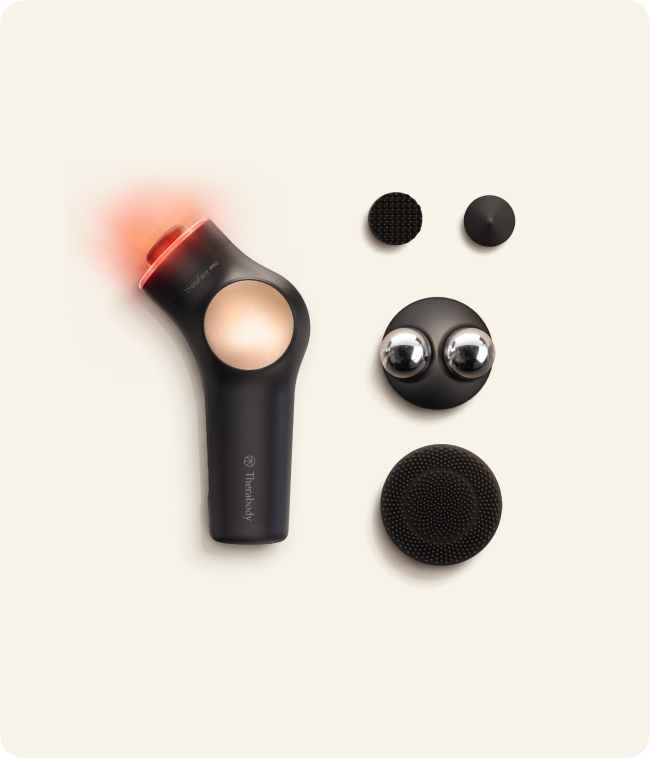
Integrating Breathwork Into Everyday Wellness Devices: How Therabody Uses Science and Technology To Make Breathwork a Sustainable Practice
Breathing is the body’s simplest and most readily available wellness tool — yet it often happens without conscious awareness. And in today’s fast-paced world, practices that calm the mind and body are more important than ever for overall wellness. An emerging trend that leverages technology to make these practices more accessible is the integration of breathing exercises into Therabody devices. Through intentional breathwork, users can calm the mind and body to promote overall wellness, improve performance, and achieve whole-body health.
By incorporating breathing exercises into everyday technology, devices promote mind-body relaxation. Read more on how Therabody integrates breathwork into wellness technology.
Why is Breathwork Important for Wellness?
To best understand the “why" behind breathwork for wellness, it’s important to understand what wellness encompasses. Wellness is the active pursuit of physical, mental, and overall well-being. And while wellness looks different for everybody, a common thread is that it’s dynamic and requires ongoing, intentional effort.
While breathing is a process that happens automatically, without intentional thought, you can intentionally control your breathing at any point. Breathwork refers to the practice of using targeted, intentional breathing exercises. In the same way that wellness requires intentional action, so too does practicing breathwork.
Practicing breathwork benefits both mind and body wellness. Slow, deep breathing exercises stimulate the parasympathetic nervous system (the “rest and digest" system), which lowers heart rate, increases heart rate variability, and reduces blood pressure. These improvements not only build resilience to stress but can also reduce symptoms of anxiety and depression, boost mood, and increase focus and attention. Even a few minutes of daily deep, diaphragmatic breathing can lower stress levels, improve heart health markers, enhance mental well-being, and increase energy and productivity. Read more about the benefits of breathwork and how to get started with simple breathing exercises here. [1, 2, 3]
How Therabody Products Include Breathing Exercises
The scientific research behind breathwork is clear — practicing intentional breathwork helps to improve health. Practicing breathwork is simple in concept, yet creating a sustainable habit out of breathwork can be challenging. So, rather than creating standalone breathwork technology, Therabody incorporates breathing exercises into technologies and devices. And because wellness isn’t one-size-fits-all, Therabody’s solutions aren’t either. Multiple breathing exercises that relax the mind, help you focus, and encourage sleep are options.
When exploring the best way to integrate breathwork into the different devices, the R&D team at Therabody had a vision to deliver an immersive and multi-sensory experience through a physical-digital ecosystem to help people experience and achieve wellness.
By taking the guesswork out of breathwork and prompting regular practice, Therabody’s technology helps to create sustainable breathwork habits in users. Therabody’s Theragun devices and connected TheraMind content make breathwork simple, approachable, and actionable, all of which help to turn breathwork from a practice to a sustainable habit.
How To Use Breathwork in Theragun Devices
Theragun models like Theragun Sense and Theragun PRO Plus combine percussive massage therapy (Theragun’s bread and butter) with calming breathwork. The combination of percussive therapy and controlled breathwork can help to reduce stress, relieve aches and pains, ease soreness, and support restful sleep.
To access breathing routines, download the Therabody app and connect your Theragun device. Select a breathing exercise on the Theragun device or through the Therabody app. The Therabody app has breathing exercises like, “Sleep Breathing," “Recovery Breathing," and “Relax Breathing," to meet users’ needs.
Measure Your Heart Rate During Breathing Exercises
The Theragun Sense and Theragun PRO Plus devices have a built-in biometric sensor for on-device heart rate readings (this feature is location-dependent). Measuring and providing real-time feedback on physiological processes in the body is a concept known as biofeedback. The thought is that seeing these metrics encourages and enables users to improve them. [4, 5]
Here is how to use the device’s biometric sensor to measure your heart rate during a breathing exercise:
- Hold the device in the “double-grip" position while keeping the tip of your pointer (index) finger placed on the biometric sensor.
- Cover the entire sensor with the tip of your finger. Do not squeeze or firmly press the biometric sensor, as this may lead to inaccurate readings.
- Select a breathing routine in the Therabody app and press play.
- The device’s haptics will vibrate at a specific rate to signal you through a calming inhaling and exhaling routine.
- During this routine, the Theragun PRO Plus device measures your heart rate. Your lowest (minimum) heart rate will be displayed following the treatment.

The Science Behind the Multi-Sensory Breathwork Experience
In addition to the Theragun device’s haptics that guide users through breathing exercises, the in-app experience also delivers relaxing visual and sound therapy. Listening to and watching the breathwork routine while experiencing haptics from the device provides a multisensory experience — stimulating sight, hearing, and touch — scientifically supported to boost learning and performance. [6]
Research shows that the human brain has evolved to function optimally in multisensory environments where visual, auditory, and other sensory information converges. Studies show that the communication and engagement of multiple senses help the brain to adapt and process information more effectively than engaging a single sense alone. [6]
For example, audio-visual training may be more effective than visual-only training. Multisensory training may be more effective because it activates more parts of the brain networks and helps create stronger representations of information. So, using tactics that combine matching information from different senses can improve learning and performance on single-sense tasks in various everyday applications. [6]
The Science of Sound Therapy
Sound has been used as a therapeutic tool and as one to cue behavior for thousands of years. More recently, scientists have explored the physical, biological, and mental effects of various musical elements and audio techniques. Sound therapy complements devices and provides benefits like relaxation and stress reduction. The breathwork tracks incorporate audio techniques such as binaural beats and isochronic tones to pace breathing exercises that induce a relaxed yet focused state.
How Therabody Created This Experience
Therabody’s in-house music technologist, scientists, and visual designers closely collaborated to create an immersive audio and visual breathwork experience. Using visuals alone to guide breathing exercises can be challenging. The experience needed to guide users on when to inhale or exhale, how long each inhale and exhale should be, and how to anticipate switching from an inhale to an exhale. Just as it sounds — this can be a lot of information to process, especially for a relaxing and calming experience. After many design iterations and user testing, the audio and visual experience you see in the Therabody app today was confirmed to be the easiest to follow and also the most relaxing. As Therabody’s science team continues to research soundscapes for optimal health, TheraMind audio will continue to deliver science-supported health benefits to users.



How to Make Breathwork a Daily Habit
Wellness is an intentional, ongoing, and ever-evolving journey. So, Therabody incorporates wellness features in technology that people already use daily.
A behavior is more likely to become a sustainable habit when frequently and consistently performed in the same context. Adding breathing protocols into a daily device allows users to start building new, healthy habits fairly seamlessly — a tactic known as habit stacking. When you perform a new habit on top of an existing one, particularly one that is enjoyable and health-promoting, habits are stacked. Studies show that habit stacking helps to speed up the adoption of a new practice, cementing it into your routine. [7, 8, 9]
Key Takeaways:
- Breathwork refers to intentional, focused breathing exercises that can improve physical and mental well-being.
- Therabody integrates breathwork features into Theragun devices that connect to the Therabody app to make breathwork more accessible as part of an overall wellness routine.
- Features like haptics, soundscapes, and visuals create a multisensory breathwork experience that is relaxing and easy to follow.
- Incorporating breathwork into existing daily wellness habits, known as “habit stacking," helps form sustainable practices.
References:
- https://pubmed.ncbi.nlm.nih.gov/29209423/
- https://pubmed.ncbi.nlm.nih.gov/24063918/
- https://pubmed.ncbi.nlm.nih.gov/15201553/
- https://pubmed.ncbi.nlm.nih.gov/32385728/
- https://ieeexplore.ieee.org/document/9086332
- https://www.sciencedirect.com/science/article/abs/pii/S1364661308002180
- https://pubmed.ncbi.nlm.nih.gov/32292376/
- https://onlinelibrary.wiley.com/doi/10.1002/ejsp.674
- https://psycnet.apa.org/doiLanding?doi=10.1037%2F0033-295X.114.4.843





